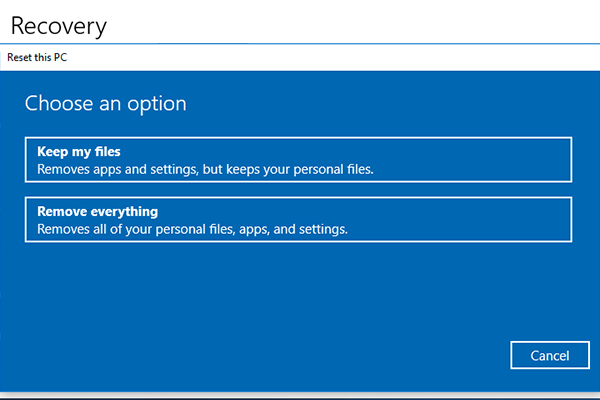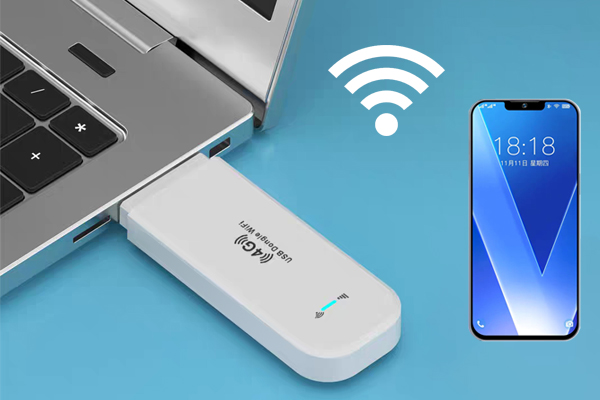- Have any questions?
- +86 19122692420
- info@aiwa-group.com

What is a convertible laptop?
January 10, 2023
How to get internet on laptop anywhere?
January 13, 2023How to completely reset, refresh, format or reformat your laptop?
You may want to reset your laptop for many reasons, such as the computer is too slow because it is loaded with too many things; the computer program is corrupted and does not work properly; the computer is attacked by a virus or Trojan horse... whatever the reason Reason, resetting your computer can indeed solve most problems, but it may also cause your useful files to be lost forever. Therefore, it is very important to know how to properly format your laptop.
What does formatting a laptop do?
1. Clear hard disk space
Formatting the computer will erase all the data in the hard disk, including various applications, data, files, media, etc. These data may be files you need, or they may be redundant data that is completely useless.
2. Delete Trojan or virus
Formatting will clear all data, including malicious programs such as viruses and Trojan horses hidden in the computer. Usually, these malicious softwares will hide or change into an unrecognizable image, and only a good antivirus program can clean them well, and formatting them can clean them completely and thoroughly.
3. Reinstall the system
After all the files on the hard drive have been wiped, the system file reinstallation will begin, and the new system files will replace the old corrupted system files, returning the computer to the state it was in when you first bought it.
When do I need to format my laptop?
If your computer has the following conditions, then you may consider formatting your computer
- The computer is attacked by a stubborn virus or Trojan horse, which cannot be cleaned up by anti-virus software, etc.
- Computer system files are damaged and cannot be repaired.
- There are too many redundant files on the computer, which leads to slow operation, and it still cannot be solved after cleaning the files.
What needs to be done before formatting?
Before formatting your computer, you need to export or back up useful files, such as your chat software data, browser storage address, copies of drivers, images and videos, etc. When you format your computer, it will be very difficult for you to get back the original files, so it is very important to do a good job of data backup.
How to format a laptop?
This article will introduce 4 methods of formatting a laptop, which are suitable for different conditions. Before starting to format your laptop, please plug in the power of the laptop, because this process will take a certain amount of time, and you need enough power to ensure The whole process runs in full.
1. Reset the computer through the system
After resetting this PC through the system function, the computer will keep the personal files that the user chooses to keep, and delete all other non-preinstalled system files. If you do not choose to keep any files, it is equivalent to formatting the computer, leaving only the preinstalled system files.
- Reset windows 7 Method 1
- Open the start menu bar and select "Control Panel";
- In the control panel, click "System";
- Click "System Protection";
- Click "System Restore";
- The restore point is generally the factory setting by default, click "Next";
- Click "Restore", the system will enter the process of restoring factory settings.
- Press the "win" key and the "R" key on the keyboard to open and run;
- Enter the "sysprep" command and click OK;
- Double-click "sysprep.exe";
- Select "Enter System Out-of-Box Experience (OOBE)", and select the "General" check box below, and then select "Shutdown Options" as "Restart", and click "OK";
- Wait for the system to complete the factory reset
- Reset windows 10
- Click the Start button to enter the Start menu, then click "Settings"
- Click "Update and Security"
- lick "Restore"
- Click "Reset this PC", then "Start", choose "Keep my files" or "Erase everything". Select "Keep My Files" to format the computer without deleting your personal files; select "Erase Everything" to delete all files and applications from the computer, returning it to how it was when it was shipped from the factory.
- When asked to confirm the action, click "Next" and select "Reset"
- Reset windows 11
- Click the Start button to enter the Start menu, then click "Settings"
- Click "Windows Update"
- Click "Advanced Options"
- Click "Restore"
- Click "Initialize PC" after "Reset this PC", and select "Keep my files" or "Delete everything". Similarly, selecting "Keep My Files" will format the computer without deleting your personal files; selecting "Erase Everything" will delete all files and applications from the computer, restoring you to a clean Windows system.
- When asked to confirm the action, click "Next" and select "Reset"
2. Format the computer through the system repair CD
1. Create a system repair disc
- Click Start>All Programs>Maintenance>Create System Repair Disc,
- In the pop-up window, select Create Disc to use the disc drive,
- Open the CD-ROM drive and insert a blank DVD disc or CD in it, and then click the "Create Disc" button,
- The system starts to create the disc. After the completion, the completion prompt will be displayed, and the dialog box shown below will pop up, and then click "Close", "OK" and other buttons in turn.
2. Use the system repair disc to format the computer
- Restart the computer, press F10 or F12 during the restart process to enter the boot menu
- Select CD as the first boot device, then click "enter", "next"
- Click Next and command prompt, enter " format c: /fs:ntfs " and press Enter, and wait for the formatting to complete
3. Format the computer via the installation CD
- Click the "Start" menu, click "Run"
- Enter CMD and press Enter
- Enter the command SFC/SCANNOW
- Insert the system CD
The system will automatically compare and repair the system files in the hard disk with the files in the system disk If not, follow the steps below.
1. First set the CD-ROM boot priority.
- Restart the computer, press the Del key to enter the BIOS (the notebook presses F2 to enter the BIOS, the settings are similar.)
- Use the arrow keys to select Advanced BIOS Features
- Press Enter to enter the BIOS setup page
- Select First Boot Device or (1st Boot Device) by arrow keys
- Use the up and down arrow keys to select CDROM
- Press ESC to return to the BIOS setup interface.
- Use the arrow keys to select Save & Exit Setup
- Press the 'Y' key and press Enter to restart the computer
2.Enter the installation steps
- After restarting the computer, use the arrow keys to move the highlighted bar to CDROM, at this time, insert the CD into the CD-ROM drive
- When Press any key to boot from CD appears on the screen, immediately press any key to enter the installation interface
- First, it will prompt you to press Enter to continue the installation, press "R" to enter the recovery console or press "F3" to exit, then press Enter instead of "R", otherwise you will enter the recovery console. Next, "The installer is searching for different versions of Windows" will appear on the screen. After this prompt, you can check whether the installer can find the original system on the hard disk. If you find it, select "repair reinstallation", and then operate according to the text prompts.
4. Format the computer via U disk
1.Make a PE system boot disk
- Prepare a 16G or above empty U disk, and then connect it to the computer
- Download the official Microsoft production tool MediaCreationTool, run the installation package and follow the prompts to complete the installation
- On the What do you want to do? page, select Create installation media for another computer, and then select Next
- Select the language, version and architecture of Window (64-bit or 32-bit) according to your needs. (You can remove the check in the lower left corner and choose windows10/64 bit. If you want to install 32 bit, choose 32 bit, but 64 bit is recommended, because 64 bit supports memory larger than 4G.)
- Select U disk as the medium, and then select Next
- Select to your U disk. Then select Next, wait patiently for the download and media creation process, and finally click Finish. (Connect a blank USB flash drive with at least 8G space, all content on the USB flash drive will be deleted).
2. Use the U disk to format the computer
- After making the U disk, connect the U disk to the machine where the system needs to be installed, restart the computer, and press the F8 (or F9, F11, F12, ESC, depending on the computer model) key to bring up the boot menu during the restart process
- After the menu options appear, select "Boot Menu" and press Enter, select "EFI USB Device" and press Enter to start the system installation
- Enter the system installation interface, select the installation language, input method, etc., and then click Next
- Click Install Now
- Select "I don't have an installation key" when activating Windows
- Choose to install the Windows version, usually choose the home version, and then click Next
- Check "I accept the license terms" and click Next
- Select "Custom: Install Windows only (Advanced)" for the installation type
- If you need to format the hard disk and repartition, delete the current hard disk partition, then click the unallocated space, click "New", enter the size, and click "Apply"
- Click "OK" in the pop-up prompt box to create a partition. If you need to create other partitions, you can go to Steps 9 and 10 again to create new ones
- Select the partition to install the system, and then click Next
- Next, the Windows files will be copied and installed. After the installation is complete, the system will restart, and the U disk needs to be pulled out when restarting
- After pulling out the U disk, it will enter the startup interface to execute the installation. This process will restart several times, waiting for the system to complete the installation
- After the system installation is complete, enter the system setting interface (the page when you just purchased and started the computer), and then complete the setting according to the prompts to enter the brand new Windows.
FAQ
How do I completely format my laptop computer?
You can choose "Erase All Content" to completely reset your computer when you restore or reset your computer, or format your computer through a USB flash drive or CD. These methods can completely reset the Windows system.
How can I format my laptop without CD?
Usually there are 3 ways to reset the computer, using the reset function of the computer, U disk and CD. If there is no CD, using the reset function of the computer and using the U disk are also effective.
Is it OK to reformat a laptop pc?
Yes, resetting your computer will clean everything from your computer, including all kinds of redundant data and harmful programs, which will make your computer run faster. But please do not reset your computer unless necessary, because you will lose all your personal files, backup files and reset process will be troublesome, and performing a full format will also shorten the life of the SSD.
Does formatting a PC delete everything?
Yes, formatting a PC will delete everything on the computer and make data recovery quite difficult. However, existing personal data can be preserved by backing up data or selecting "Keep my files" when using the system reset function.
How do I format my laptop using USB?
To use USB to format the computer, you need to make a PE system boot disk first, and then use it to reset the computer and install the system. For detailed steps, please refer to the above tutorial.
Can I format my PC without USB?
Usually there are 3 ways to reset the computer using the reset function of the computer, U disk and CD. If there is no USB, using the reset function of the computer and using the CD are also effective.
Does reformat remove all viruses?
Formatting erases all files from the computer, and in most cases, it also completely removes dangerous programs such as Trojan horse viruses that have infected the computer. There is also a chance that programs such as viruses can return to the computer if the data is restored after formatting.
Does full format damage SSD?
A full format will not damage the SSD, but will shorten the lifespan of the SSD. The life of an SSD depends on its erasable times. A complete format will perform a complete read/write cycle, which will reduce the usable time of the SSD to a certain extent.
Can you reformat without losing data?
Yes, you can use the backup function in Windows7,8,10,11 to back up your data in advance to protect your data, the path is: Start > Update and Security > Backup > Go to Backup and Restore (Windows 7) > Set up Backup.




